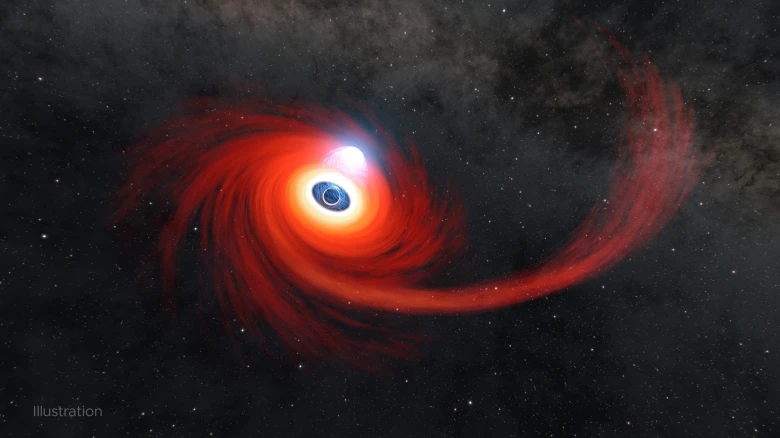Regional

The supermassive black hole nestled at the center of our Milky Way, known as Sagittarius A*...
Digital Desk: In the vast tapestry of the cosmos, black holes are the insatiable gluttons, renowned for their voracious appetite, often gulping down stars that venture too close, and annihilating them with their overwhelming gravitational force. However, in an intriguing cosmic twist, a group of researchers has stumbled upon a supermassive black hole that seems to prefer nibbling rather than gorging on its celestial prey.
This extraordinary celestial phenomenon was observed as astronomers turned their attention to a supermassive black hole residing at the heart of a nearby galaxy, which displayed an appetite for a star akin in size and composition to our own sun. Astonishingly, this ravenous black hole, situated approximately 520 million light-years away from our solar system, has developed a peculiar predilection for consuming stellar matter equivalent to about three times the mass of Earth each time the star pays a close visit during its elongated oval-shaped orbit.
Black holes, these enigmatic cosmic entities, are known for their unparalleled gravitational pull, so potent that even light cannot escape their clutches. Yet, this particular black hole, while not diminutive by any means, is relatively modest when measured on the cosmic scale, estimated to possess a mass merely a few hundred thousand times greater than our sun. In stark contrast, the supermassive black hole nestled at the center of our Milky Way, known as Sagittarius A*, looms with a staggering mass equivalent to around four million times that of our sun. Some galaxies are even known to house supermassive black holes that tip the scales at hundreds of millions of times the solar mass.
Also Read : Apple to launch affordable MacBook in 2024, may cost less than Apple iPhone 14
Unveiled amidst this cosmic grandeur is the perpetual dance of this sun-like star, ensnared by the gravitational grasp of the supermassive black hole at the core of a spiral-shaped galaxy. The invaluable data that contributed to this revelation primarily stemmed from NASA's Neil Gehrels Swift Observatory, orbiting our planet, offering astronomers a front-row seat to this cosmic feast.
This star, in its intricate celestial choreography, encircles the black hole every 20 to 30 days. During each close encounter, the star ventures near enough to the black hole to have portions of its stellar atmosphere drawn away, or accreted, but miraculously escapes the gruesome fate of being entirely devoured. This recurrent celestial ballet has been aptly termed a "repeating partial tidal disruption."
As the unfortunate star's matter falls into the voracious maw of the black hole, it ignites to temperatures soaring to an astounding 3.6 million degrees Fahrenheit (2 million degrees Celsius), resulting in the emission of colossal amounts of X-rays, subsequently captured by the vigilant gaze of the space observatory.
Astrophysicist Rob Eyles-Ferris, affiliated with the University of Leicester in England and one of the authors of the study published in the journal Nature Astronomy, articulated the unfolding cosmic drama, stating, "What's most likely to happen is the star's orbit will gradually decay and it will get closer and closer to the supermassive black hole until it gets close enough to be completely disrupted." However, this spectacular conclusion remains on a cosmic timescale, potentially stretching across years, decades, or even centuries.
This revelation marks an unprecedented milestone in the realm of astrophysics, as it represents the first documented instance of a star akin to our sun repeatedly being nibbled upon by a supermassive black hole. Rob Eyles-Ferris notes, "There are lots of unanswered questions about tidal disruption events and exactly how the orbit of the star affects them. It's a very fast-moving field at the moment. This one has shown us that new discoveries could come at any time."
In the vast expanse of the cosmos, where mysteries continue to unravel and celestial marvels astound, the tale of this star and its peculiar celestial courtship with a supermassive black hole stands as a testament to the boundless wonders of the universe, inviting humanity to further explore and unravel the cosmic enigmas that lie beyond our celestial doorstep.
Leave A Comment